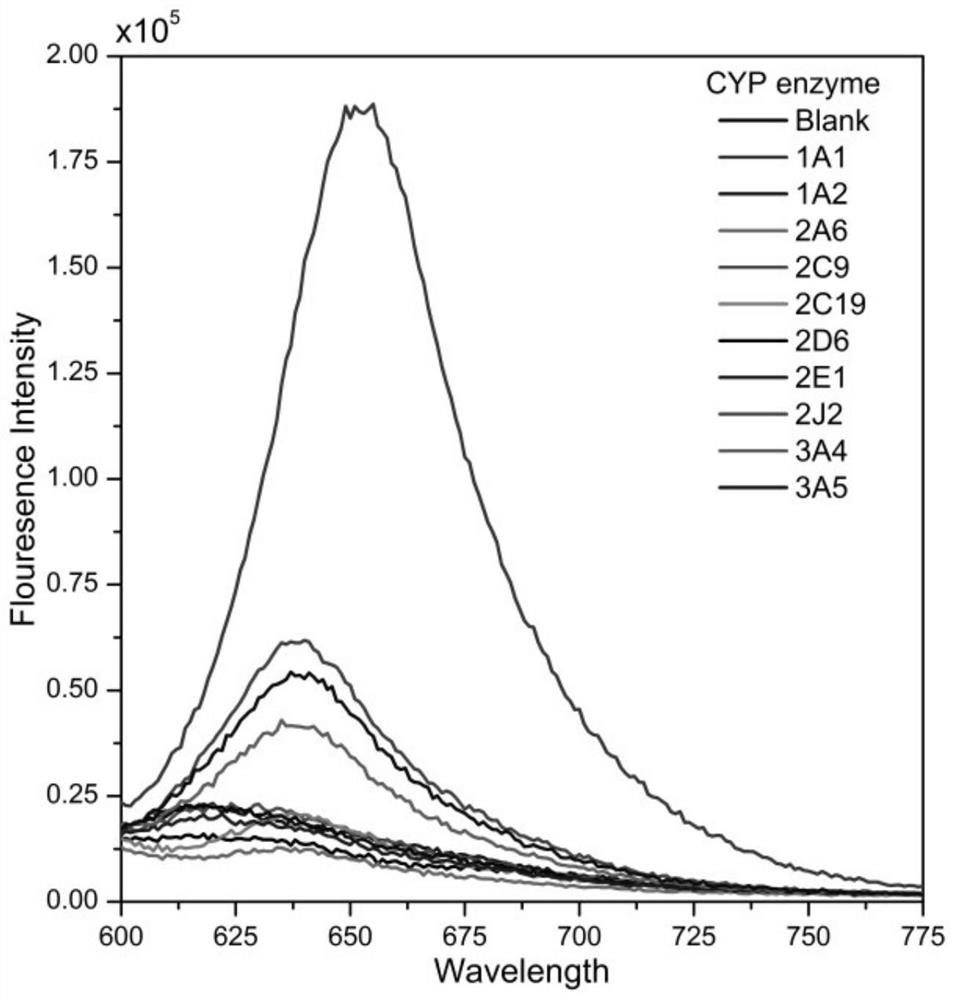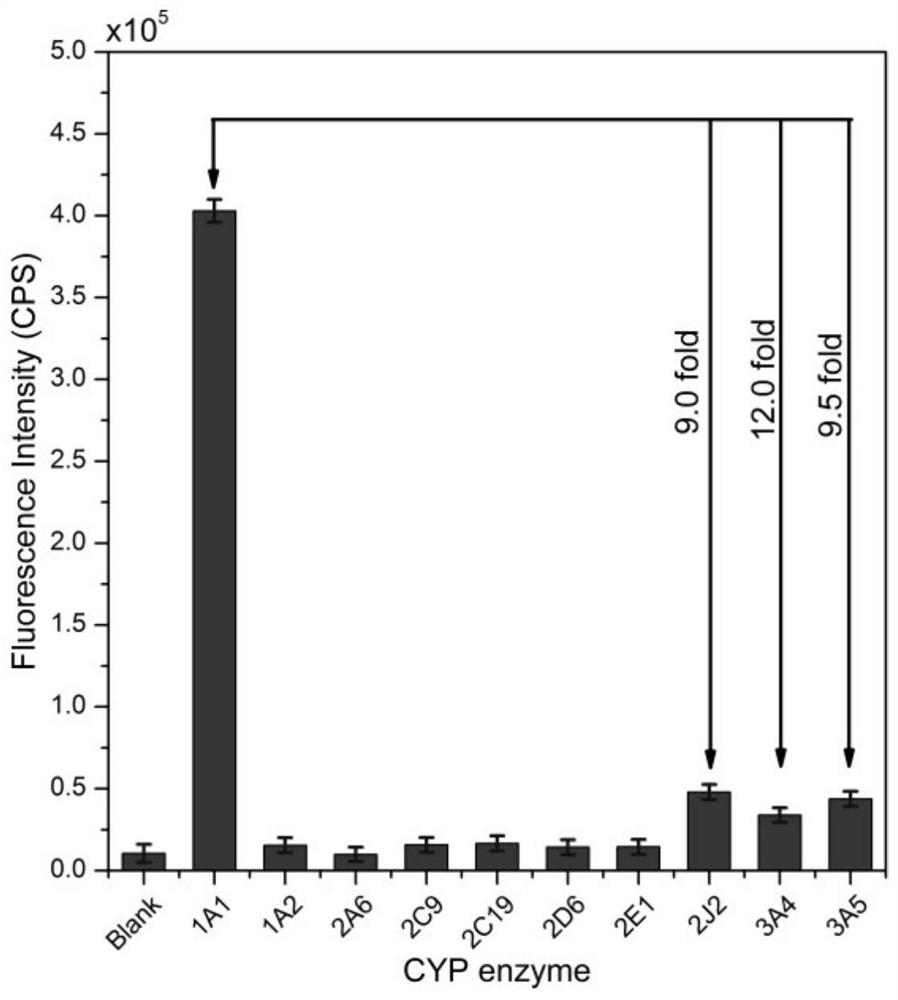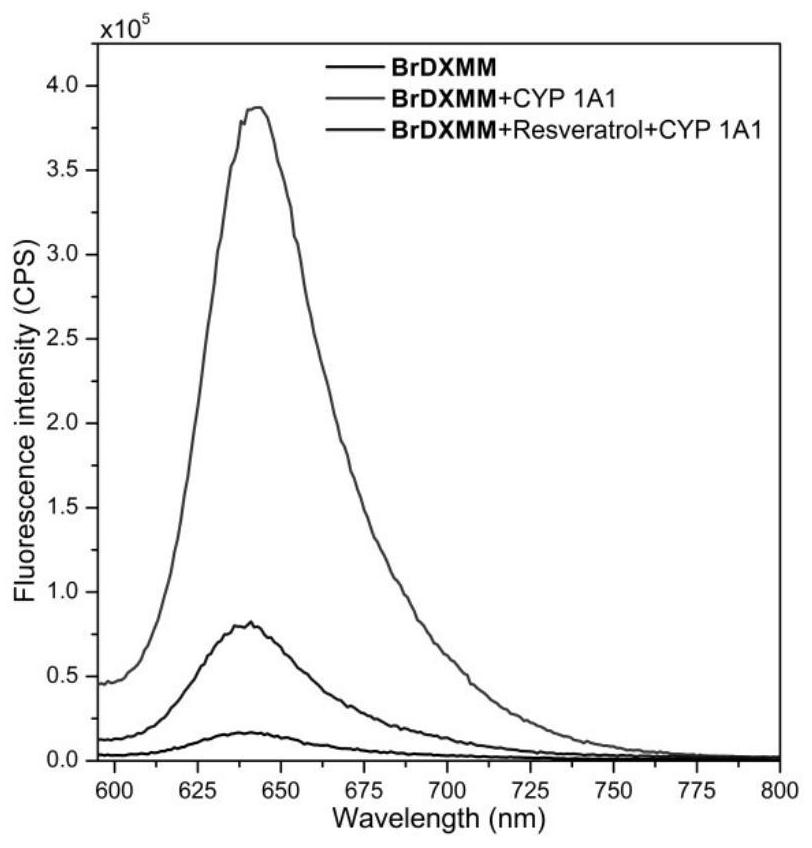Near-infrared fluorescent probe for detecting CYP 1A1 enzyme
A CYP1A1, fluorescent probe technology, applied in the field of near-infrared fluorescent probes, can solve the problems of low selectivity and biological interference, and achieve the effect of wide application range, high selectivity and good biocompatibility
- Summary
- Abstract
- Description
- Claims
- Application Information
AI Technical Summary
Problems solved by technology
Method used
Image
Examples
Embodiment 1
[0030] Fluorescent probe of the present invention 2-((6-((4-(2-bromoethoxy)benzyl)oxy)-2,3-dihydro-1H-xanthin-4-yl)methylene) Malononitrile (BrDXMM) is prepared as follows:
[0031] 1mmol of HDXMM (HDXMM of the present invention is prepared by the synthetic method disclosed in the following documents: Sensors&Actuators: B.Chemical 273 (2018) 167-175), 2mmol of potassium carbonate and 1.2mmol of 4-(2-bromoethoxy ) benzyl bromide was placed in a 25mL two-necked bottle, and then 8mL of N,N-dimethylformamide was added to the two-necked bottle, and the reaction material was heated to 90°C under nitrogen protection, and the reaction was stirred for 1 hour; after the reaction After cooling to room temperature, the reaction solution was added to cold water, stirred vigorously, and a large amount of dark red solid was precipitated, filtered, and the filter cake was separated by column chromatography (developing solvent: ethyl acetate:petroleum ether=5:1, v:v ), to obtain a dark red so...
Embodiment 2
[0032] Example 2: Determination of the selectivity of the fluorescent probe BrDXMM to each subtype of CYP450
[0033]Preparation of phosphate buffered saline solution (PBS): weigh sodium dihydrogen phosphate dihydrate (0.7410g), disodium hydrogen phosphate dodecahydrate (7.2495g) and magnesium chloride hexahydrate (0.2030g) with an analytical balance and place them in a 100mL beaker , add twice distilled water (total 200mL) to the beaker in 4 times to fully dissolve, let it stand still, transfer to a 250mL volumetric flask, and add twice distilled water to make up the volume, fully shake evenly, and then test the pH of the buffer with a pH meter . Prepare PBS buffer (0.1M, pH 7.4, c(MgCl 2 )=4.0mM), store at 4°C.
[0034] Configuration of the reaction substrate solution: weigh BrDXMM and dissolve it in dimethyl sulfoxide to prepare a mother solution with a concentration of 5 mM. Take 40 μL of the mother solution and add it to 4.96 mL of PBS buffer to prepare a 40 μM reactio...
Embodiment 3
[0037] Embodiment 3: the chemical inhibition experiment of fluorescent probe BrDXMM
[0038] Add 100 μL of the above glucose-6-phosphate solution, 50 μL of β-nicotinamide adenine dinucleoside phosphate solution, 5 μL of glucose-6-phosphate dehydrogenase solution, and 5 μL of CYP 1A1 ( Final concentration 50nM), resveratrol (final concentration 25μM, CYP 1A1 specific inhibitor), after mixing, add 10μL, 40μM BrDXMM (final concentration 10μM), and finally dilute to the corresponding concentration with PBS buffer. Then the above mixture was mixed and incubated in a constant temperature water bath at 37°C for 60 minutes. At the end of the incubation, dimethyl sulfoxide (200 μL) was added to the reaction system to terminate the reaction and mixed well. The mixture was centrifuged at low temperature (13,300×g, 4°C) for 20 minutes, and the supernatant was taken for fluorescence analysis by image 3 It can be seen that the fluorescent probe BrDXMM of the present invention does produc...
PUM
 Login to View More
Login to View More Abstract
Description
Claims
Application Information
 Login to View More
Login to View More - R&D
- Intellectual Property
- Life Sciences
- Materials
- Tech Scout
- Unparalleled Data Quality
- Higher Quality Content
- 60% Fewer Hallucinations
Browse by: Latest US Patents, China's latest patents, Technical Efficacy Thesaurus, Application Domain, Technology Topic, Popular Technical Reports.
© 2025 PatSnap. All rights reserved.Legal|Privacy policy|Modern Slavery Act Transparency Statement|Sitemap|About US| Contact US: help@patsnap.com



